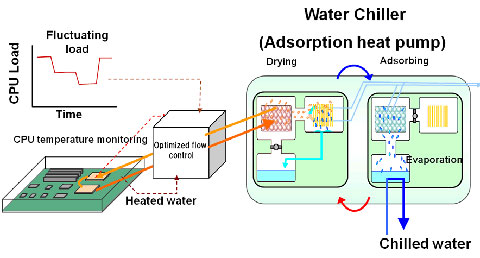Fujitsu Develops Cooling Technology Using CPU’s Waste Heat
Fujitsu today announced the development of cooling technology that employs waste heat generated by CPUs to produce chilled water that can be used to cool server rooms. Producing water of a temperature low enough for use in cooling factory equipment requires a substantial amount of energy. Currently, water is normally chilled using electricity, boilers or other sources of thermal energy, but now there are new attempts to employ heat, including that from high temperature waste water, as an energy source. Fujitsu has developed a technology that can chill water from relatively low-temperature sources that have not been usable in the past. At 55C, water produced from water-cooled type CPUs is of a relatively low temperature, which fluctuates depending on load. However, it is possible to continuously produce chilled water even from this waste water. Using water chilled by the waste heat from CPUs in air-conditioning systems can reduce total air-conditioning power requirements for a datacenter by roughly 20%. This means that the volume of CO2 cut by a single server rack, which consumes up to 12,000 kWh per year, is equivalent to 360 cedar trees.

Most factories currently produce chilled water using electricity as a way to cool equipment. However, efforts are also being undertaken to produce chilled water from high-temperature waste heat. If this principle could be applied to a datacenter, using the energy in the waste heat from CPUs to chill water that would be used as a coolant, then the power needed to cool the datacenter would be reduced. But continuously chilling water requires hot water that is consistently at 65C or above. At temperatures below that level, the variable loads on CPUs make the waste heat from IT resources difficult to exploit, so it is merely carried to the outdoors by the air conditioning, without being used productively for cooling.

Comments are closed.